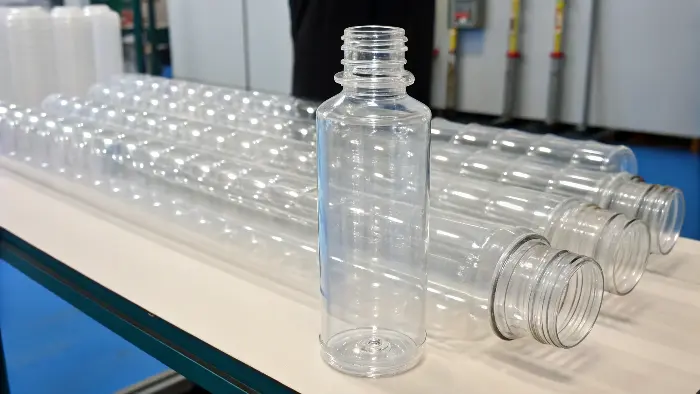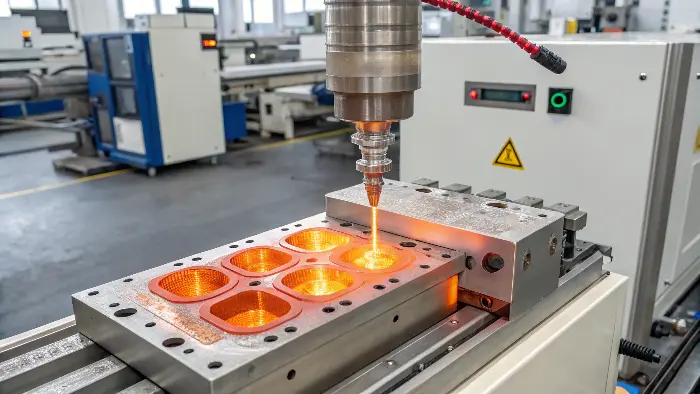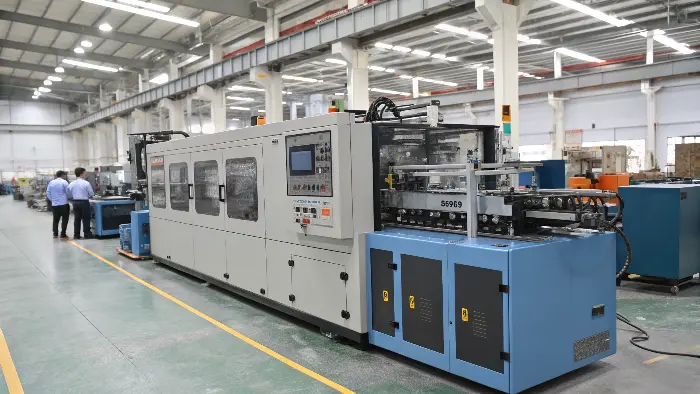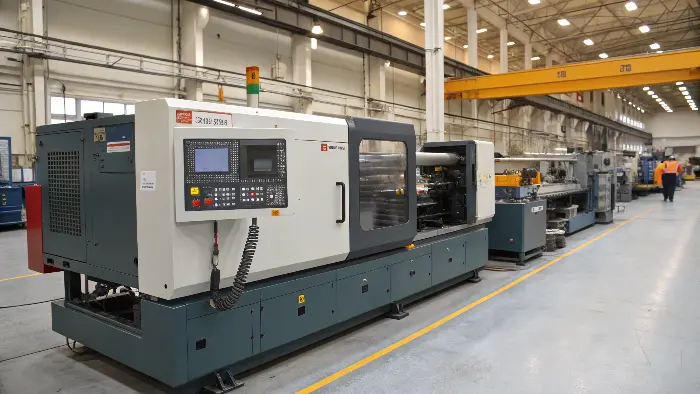Having some difficulties with the comprehension of the special machine equipment? You read words such as 180 ton PET pre form injection moulding machine and get lost. This multisyllabic mouthful actually refers to one of the main components in the manufacturing of the common plastic bottles, and here I am to demystify it to you.
An industrial equipment is a 180 ton PET preform injection molding machine. It employs the injection molding technique in production of PET preforms. These are the initial forms which the bottles we use on a daily basis, are blown into. The 180 ton section can be referred to as its clamping force that is important in ensuring that the mold remains firmly clamped together throughout the production process.

Having an idea of what we are going into, you may be curious of what the details are. It is really good to understand all the components and processes so you can learn how important or significant it is in the manufacturing. So, how does all this tie in together? Let us take a look. In my opinion, one should see the parts in order to have a clearer picture of the whole.
What is a PET preform?
Have you ever thought why plastic bottles originate? It is no magic but a certain production work. As a person engaged in the manufacture of products or packaging them in containers, you need to familiarize yourself with the PET preforms so that you know the cycle of construction of containers using these raw materials.
A preform of PET is an intermediate of occurring of bottles manufactured by a PET material. It is a hollow vessel which resembles a thick-walled test tube with the neck threads already made on the bottle. These preforms are manufactured in the form of Polyethylene Terephthalate (PET) resin which is subsequently heated into stretched-blown molds to give them the final bottle design. Their quality has a direct bearing on integrity and appearance of the final bottle.

Now we will take a closer look at PET preforms. Such small things are not as simple as it seems. They are especially designed to evolve into something bigger and useful.
The body (Polyethylene Terephthalate, or PET) used in it is selected because of its strength, translucency, and barrier effect. It is a kind of polyester.
But why go about using a two step process of preforms? To begin with, it is economical. Preforms are easily and cheaply transported and stored because they are small and compact in contrast with fully formed bottles. Consider that it would cost millions of bottles instead of millions of microscopic preforms to ship. The saving is huge in space. Second, there are two steps that can be optimized (injection molding of the preform followed by blow molding the bottle). Preforms can be produced at one facility and transported to other bottling centers across the globe.
I remember when I first started working with a client on their new mineral water bottle line. The consistency of the preform weight and the precision of the neck finish were absolutely critical. Even a tiny variation in weight could lead to thin spots when the bottle was blown. A poorly formed neck finish meant the caps wouldn’t seal properly, leading to leaks. We learned very quickly that paying attention to preform quality, whether we bought them or made them ourselves, saved a lot of trouble and money later on.
Here are some key characteristics of a good preform:
| Feature | Importance |
|---|---|
| Neck Finish | Ensures a proper and secure seal with the cap. |
| Weight | Determines the final bottle’s volume and wall strength. |
| Wall Thickness | Affects even material distribution during blowing. |
| Clarity | Important for aesthetic appeal and detecting impurities. |
| Material Grade | Must be suitable for the intended contents (e.g., carbonated drinks, hot-fill). |
| Gate Vestige | Should be minimal to avoid issues in blowing or aesthetics. |
Understanding these aspects of a PET preform helps you appreciate why the machines that make them, like the 180-ton PET preform injection molding machine, need to be so precise.
What is PET injection molding?
Heard about injection molding but unsure how it applies to PET? This process is a cornerstone of plastic manufacturing. If you’re aiming for high-volume, consistent plastic parts like bottle preforms, understanding PET injection molding is key to your success.
PET injection molding is a manufacturing process where molten Polyethylene Terephthalate (PET) resin is injected under high pressure into a precisely machined mold cavity. Once the PET cools and solidifies, the mold opens to eject the formed part, such as a preform. This method is ideal for producing large quantities of identical items with high precision.

Let’s look closer at the PET injection molding process. It’s a cycle that repeats very quickly to produce thousands or even millions of parts.
First, the PET resin, which usually comes in small pellets, must be thoroughly dried. PET is hygroscopic, meaning it absorbs moisture from the air. If you try to mold wet PET, the water turns to steam at high temperatures and causes defects in the part, like splay marks or reduced strength. So, drying is a critical first step.
Next, the dried resin is fed into the injection molding machine. Inside the machine, a screw melts the resin and conveys it forward. This molten plastic is then injected at high speed and pressure into a closed mold. The mold contains cavities shaped like the desired preform.
The plastic is held under pressure in the mold for a short time to ensure it fills completely. Then, it cools and solidifies, taking the shape of the mold cavity. Finally, the mold opens, and the finished preforms are ejected. The cycle then starts again.
In my early days in the mold business, we once took on a project for PET preforms without fully appreciating the nuances of PET. We had experience with other plastics, but PET was different. We faced persistent problems with splay marks and parts that were too brittle. After much troubleshooting, we traced the issue back to inadequate drying of the PET resin. It was a costly lesson, but it taught me that with PET, you absolutely cannot cut corners on material preparation. A good, reliable drying system is just as important as the injection molding machine itself.
Here are the key stages and critical factors:
| Stage | Critical Factor |
|---|---|
| Material Drying | Moisture content must be extremely low (e.g., <0.005%). |
| Melting | Consistent temperature, avoiding material degradation. |
| Injection | Precise control of speed, pressure, and shot size. |
| Holding Pressure | Ensures complete cavity fill and compensates for shrinkage. |
| Cooling | Uniform cooling for dimensional stability and short cycle times. |
| Mold Design | Proper gate location, venting, and cooling channels are vital. |
Specialized PET injection molding machines often have features tailored for these requirements, like screws designed for PET and robust clamping units.
What are the challenges in PET injection?
Although PET injection moulding sounds simple and straightforward, the process involves a host of parameters. Material dryness, melt temperature, mould temperature, pressures, ventilation and injection speed must all be configured with the right values, set at the right times, to achieve perfect results. PET is very sensitive to water and must be meticulously dried before production.
It is also sensitive to high temperatures, so it is critical to adhere to the established pressures, times and temperatures, , PET was mainly used in blow moulding to produce thin-walled products. Thick-walled products require injection moulding, however, and the process is more complex. The material properties have to be in perfect sync with the mould shape and design, as well as the injection moulding machine.
What is the cost of PET preform manufacturing machine?
Thinking of making PET preforms in-house? The initial investment of equipment can be daunting. In making the decision on whether the advantages outweigh the disadvantages, having an idea what goes into the price of a PET preform manufacturing machine makes for a good informed decision.
The cost of a PET preform making machine, say, a 180-ton one for preforms, is significantly determined by several factors. They are the make, originating country (e.g., European, Asian), new or second-hand status, number of mold cavities it can handle, level of automation, and auxiliary equipment supplied. Prices can be very varied, from tens of thousands to a few hundred thousand American dollars.

Let us consider the determinants of the cost of a PET preform production machine, for example, one of 180 tons.
Machine size, specifically in terms of its clamping force (tonnage), is a matter of consideration. A 180-ton machine is a particular size, but as a rule of thumb, the larger the tonnage, the more expensive because the machine is larger, requires more material, and has heavier parts.
Brand and country of origin play significant roles. German, Japanese, or Swiss reputable brands would generally be in the premium segment. They generally have superior technology, high precision, and decent after-sales service. Chinese, Taiwanese, or Indian machines could be low cost but no guarantee for quality and service.
Whether you buy new or old is another big consideration. Used equipment will be much cheaper to buy. But it may be more expensive to repair, have no warranty, and possibly outdated technology.
The mold itself is a separate, major cost, but the machine must be compatible with the mold. The number of cavities in the preform mold (e.g., 16, 32, 48, or more cavities) affects the machine size needed and the overall system cost. More cavities mean higher output but also a more expensive mold and often a more robust, and thus pricier, machine.
Auxiliary equipment is essential and adds to the total investment. This includes PET resin dryers, mold temperature controllers (chillers), material loaders, conveyors, and sometimes robots for part removal.
The level of technology also impacts price. For example, all-electric machines are generally more expensive than hydraulic machines but offer energy savings and higher precision. Machines specifically designed for PET often have optimized screws, heating elements, and control systems, which can add to the cost.
I recently helped a client start up their own preform production line. They were strongly tempted by a deal on a very low-cost, used machine with an unknown manufacturer. I asked them to look beyond the upfront cost of acquisition and consider any total cost of ownership. We estimated potential downtime, availability of spare parts, energy consumption, and probable preform quality. They went with a slightly more expensive new machine from a reputable local vendor that had good local service. It was a far better investment in the long run because they had less downtime and made good-quality preforms every time. With a specialty piece of equipment like a 180-ton PET machine, you are paying for accuracy and reliability, so the price will be higher.
Here’s a table summarizing cost factors:
| Cost Factor | Impact on Price |
|---|---|
| Machine Tonnage (e.g., 180 ton) | Higher tonnage generally increases price. |
| Brand Reputation | Premium, well-established brands cost more. |
| Country of Origin | Significant price differences (e.g., Europe vs. Asia). |
| New vs. Used | Used is cheaper initially but may have hidden costs. |
| Mold Cavitation Support | Machines for high-cavitation molds are more robust. |
| Automation Level | Robots, advanced controls, and integration add cost. |
| Auxiliary Systems Included | Dryers, chillers, loaders are often separate but essential. |
| Technology (Hydraulic/Electric) | All-electric typically costs more upfront. |
Careful evaluation of these factors against your specific production needs and budget is key.
Impact of Improper Tonnage Calculation
Effects of Inaccurate Tonnage Estimation
An excessively low clamping force is likely to produce inconsistent outcomes or flaws, such as uneven surface polish, flash, short shots, and changes in wall thickness and size and weight. Excessive clamping force shortens a tool’s lifespan by causing needless wear and tear, which eventually raises manufacturing costs because the tool must be rebuilt more frequently.
High clamping force machines are more costly than those with lower clamping forces, and a less skilled or generic molder might not have the appropriate machine size for your project. Accurate tonnage calculations by plastics engineers at CKMold guarantee that the right machine is used and remove the possibility of overclamping.
What is the cost of 200 ton injection molding machine?
With a one-size-up machine, perhaps a 200-ton machine? The added tonnage impacts cost and performance. If you’re considering options or need some extra clamping pressure on your molds, understanding the cost drivers of a 200-ton machine will guide your investment.
The cost of a 200-ton injection molding machine will follow the same rules as for the other sizes but will generally cost more than a smaller machine like an 180-ton machine. Brand, new or used, features (hydraulic, hybrid, all-electric), country of origin, and any auxiliary equipment included are important factors. Budget a range of mid-tens of thousands to over a hundred thousand U.S. dollars, or more for a high-end European or Japanese model.

You might wonder why we’re discussing a 200-ton machine when the main topic is a 180-ton PET preform machine. Sometimes, the specific mold a client has, or the number of preform cavities they want to run, might require just a bit more clamping force than a 180-ton machine can comfortably provide. A 200-ton machine offers that slightly larger capacity. It’s also a very common size in the industry, so people often inquire about it.
The cost factors are largely the same as we discussed for the PET preform machine: brand, origin, new/used, technology (hydraulic, hybrid, or all-electric), and the scope of supply (auxiliaries included or not).
The price difference between a 180-ton and a 200-ton machine from the same manufacturer and series might not be enormous, but it will be noticeable. The 200-ton machine is physically larger, contains more material, and has more powerful hydraulic or electric systems.
What can a 200-ton machine do that a 180-ton might struggle with? It can handle molds with a slightly larger projected area. The projected area is the surface of the part perpendicular to the clamping direction. The machine needs enough force to keep the mold closed against the injection pressure acting on this area. So, if your preform mold has many cavities, or if you plan to use the machine for other parts besides preforms that are larger, a 200-ton machine might be a better fit. It provides a wider processing window for certain applications.
I typically advise my clients that choosing the right tonnage matters. It’s not a question of picking a number. You need to determine the clamping force that your specific mold and material need. Although a 180-ton machine is adequate for most PET preform applications, if your calculations show you’re really at its limit, making the jump to a 200-ton machine can provide a cushion and perhaps better mold life and part quality. Don’t just compare the price of the machine; consider the overall efficiency and reliability for your specific production.
Here’s a general comparison:
| Feature Comparison | 180 Ton Machine (Typical) | 200 Ton Machine (Typical) |
|---|---|---|
| Clamping Force | Approx. 1800 kN | Approx. 2000 kN |
| Max Mold Size (LxW) | Slightly Smaller | Slightly Larger |
| Tie Bar Spacing | Generally Smaller | Generally Larger |
| Energy Consumption | Potentially Lower | Potentially Higher (esp. hydraulic) |
| Price Point (Base) | X | X + Increment |
| Suitability | Many PET preform molds | Larger preform molds, other parts |
Always consult with machine manufacturers and provide your mold specifications to get accurate recommendations and pricing.
Conclusion
A 180-ton PET preform injection molding machine is a high-end, specialized machine in the business of making PET bottles. Knowing about the preforms themselves, the nuances of the PET injection molding process, and the cost implications of using these machines enables you to make better, more informed choices. I hope this description by CKMOLD has made its function and worth clear in the manufacturing sector.
